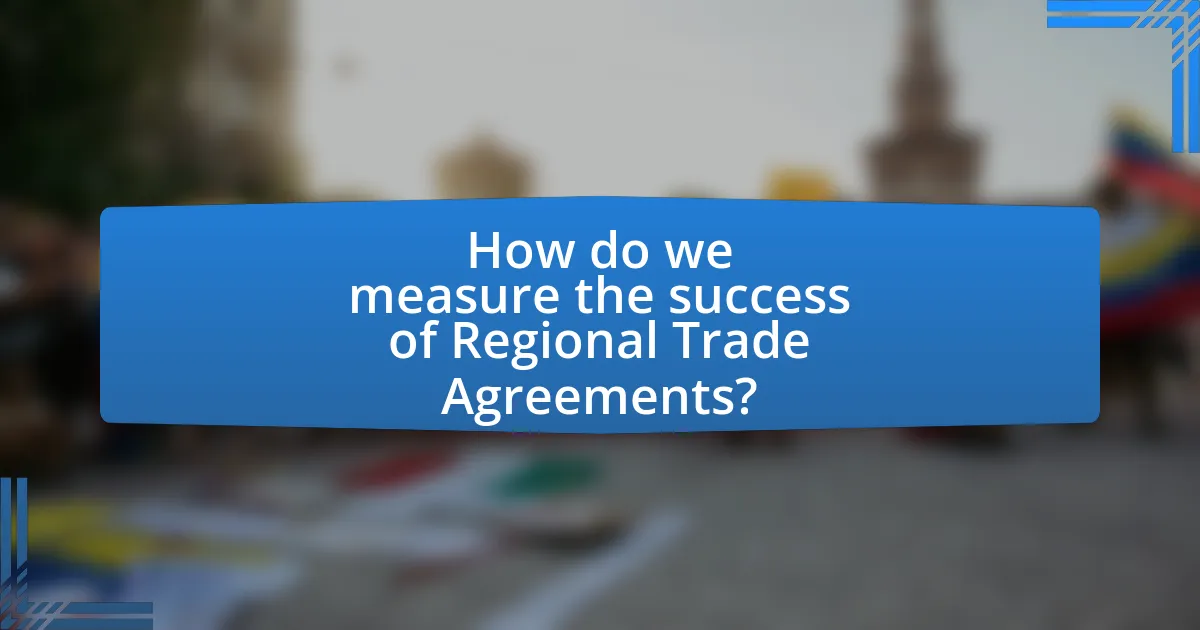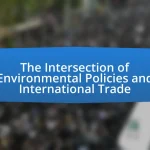Regional Trade Agreements (RTAs) are treaties between countries aimed at facilitating trade by reducing tariffs and other barriers. This article evaluates the success of RTAs by examining their key components, such as tariff reductions, trade facilitation measures, and dispute resolution mechanisms, and how these elements interact to enhance trade flows and economic cooperation. It also discusses the economic benefits of RTAs, including increased trade volumes and foreign direct investment, while addressing the challenges in measuring their success, such as differing economic conditions among member countries and limitations in existing evaluation frameworks. The article concludes with insights on best practices for designing effective future agreements and practical steps countries can take to enhance the success of RTAs.

What are Regional Trade Agreements?
Regional Trade Agreements (RTAs) are treaties between two or more countries that aim to facilitate trade by reducing or eliminating tariffs and other trade barriers. These agreements can take various forms, including free trade agreements, customs unions, and common markets. RTAs are significant because they can enhance economic cooperation, increase trade flows, and promote investment among member countries. For instance, the North American Free Trade Agreement (NAFTA), implemented in 1994, significantly boosted trade between the United States, Canada, and Mexico, demonstrating the potential economic benefits of such agreements.
How do Regional Trade Agreements function?
Regional Trade Agreements (RTAs) function by facilitating trade between member countries through the reduction or elimination of tariffs and other trade barriers. These agreements create a preferential trading environment, allowing member nations to engage in more efficient trade practices, which can lead to increased economic growth and integration. For example, the North American Free Trade Agreement (NAFTA), implemented in 1994, significantly reduced tariffs between the United States, Canada, and Mexico, resulting in a tripling of trade among these countries over two decades. This demonstrates how RTAs can enhance trade flows and economic cooperation among member states.
What are the key components of Regional Trade Agreements?
The key components of Regional Trade Agreements (RTAs) include tariff reductions, trade facilitation measures, rules of origin, and dispute resolution mechanisms. Tariff reductions involve the elimination or reduction of customs duties on goods traded between member countries, which enhances trade flows. Trade facilitation measures streamline customs procedures and reduce non-tariff barriers, making it easier for goods to move across borders. Rules of origin establish the criteria for determining the national source of a product, ensuring that only goods produced within the member countries benefit from the agreement. Dispute resolution mechanisms provide a structured process for resolving trade disputes that may arise between member states, promoting stability and compliance with the agreement. These components collectively aim to enhance economic integration and cooperation among member countries.
How do these components interact to facilitate trade?
Regional trade agreements (RTAs) facilitate trade by reducing tariffs, harmonizing regulations, and enhancing cooperation among member countries. These components interact by creating a more predictable and stable trading environment, which encourages investment and economic integration. For instance, the reduction of tariffs lowers the cost of goods, making them more accessible to consumers and businesses, while harmonized regulations simplify compliance for exporters and importers. Additionally, enhanced cooperation fosters trust and collaboration, leading to increased trade volumes. According to the World Trade Organization, RTAs have contributed to a significant increase in global trade, demonstrating their effectiveness in facilitating trade through these interactions.
Why are Regional Trade Agreements important?
Regional Trade Agreements (RTAs) are important because they facilitate trade by reducing tariffs and other trade barriers among member countries. These agreements promote economic integration, enhance market access, and stimulate economic growth by allowing countries to specialize in their comparative advantages. For instance, the North American Free Trade Agreement (NAFTA), implemented in 1994, significantly increased trade among the U.S., Canada, and Mexico, leading to a tripling of trade volume by 2016. Additionally, RTAs can attract foreign direct investment, as companies seek to benefit from preferential trade terms, further boosting economic development in member nations.
What economic benefits do Regional Trade Agreements provide?
Regional Trade Agreements (RTAs) provide significant economic benefits, including increased trade flows, enhanced market access, and improved economic cooperation among member countries. These agreements typically reduce or eliminate tariffs and other trade barriers, leading to a rise in exports and imports between the participating nations. For instance, the North American Free Trade Agreement (NAFTA) resulted in a 20% increase in trade among the U.S., Canada, and Mexico from 1993 to 2000, demonstrating how RTAs can stimulate economic activity. Additionally, RTAs often attract foreign direct investment (FDI) by creating a more stable and predictable trading environment, which further contributes to economic growth.
How do Regional Trade Agreements impact member countries?
Regional Trade Agreements (RTAs) significantly impact member countries by facilitating trade liberalization, which leads to increased economic growth and enhanced market access. These agreements typically reduce or eliminate tariffs and other trade barriers among member nations, promoting a more competitive environment. For instance, the North American Free Trade Agreement (NAFTA) resulted in a 20% increase in trade among the U.S., Canada, and Mexico from 1993 to 2000, demonstrating the effectiveness of RTAs in boosting trade volumes. Additionally, RTAs can attract foreign direct investment (FDI) by creating larger, more integrated markets, as seen in the European Union, where member countries benefit from a single market that encourages investment and economic collaboration.

How do we measure the success of Regional Trade Agreements?
The success of Regional Trade Agreements (RTAs) is measured through various quantitative and qualitative indicators. Key metrics include trade volume changes, economic growth rates, and foreign direct investment (FDI) inflows among member countries. For instance, the North American Free Trade Agreement (NAFTA) led to a 30% increase in trade between the U.S., Canada, and Mexico from 1993 to 2000, demonstrating significant trade volume growth. Additionally, the impact on GDP growth can be assessed; studies show that countries participating in RTAs often experience higher GDP growth rates compared to non-participating countries. Furthermore, the analysis of tariff reductions and non-tariff barriers provides insight into the effectiveness of RTAs in promoting trade liberalization. These metrics collectively offer a comprehensive evaluation of the success of Regional Trade Agreements.
What indicators are used to evaluate the success of Regional Trade Agreements?
Indicators used to evaluate the success of Regional Trade Agreements (RTAs) include trade volume changes, economic growth rates, tariff reductions, and foreign direct investment (FDI) flows. Trade volume changes assess the increase or decrease in goods and services exchanged between member countries post-agreement, while economic growth rates measure the overall economic performance of the countries involved. Tariff reductions indicate the extent to which trade barriers have been lowered, facilitating easier trade. FDI flows reflect the level of investment from foreign entities, which can be influenced by the stability and attractiveness of the trade environment created by the RTA. These indicators provide a comprehensive view of the economic impact and effectiveness of RTAs.
How do trade volume and economic growth serve as indicators?
Trade volume and economic growth serve as indicators of a region’s economic health and integration within global markets. High trade volume typically reflects increased economic activity, suggesting that a region is effectively engaging in international commerce, which can lead to higher GDP growth rates. For instance, according to the World Bank, countries that have increased their trade volume by 10% often experience GDP growth rates that are 1-2% higher than those that do not. This correlation indicates that as trade volume rises, it often stimulates economic growth through job creation, investment, and innovation. Thus, both trade volume and economic growth are critical metrics for assessing the effectiveness of regional trade agreements and their impact on economic prosperity.
What role does foreign direct investment play in measuring success?
Foreign direct investment (FDI) serves as a critical indicator of economic success in the context of regional trade agreements. FDI reflects the confidence of foreign investors in a country’s economic stability and growth potential, often leading to job creation, technology transfer, and increased productivity. For instance, according to the United Nations Conference on Trade and Development (UNCTAD), global FDI flows reached $1.5 trillion in 2020, demonstrating the significant impact of trade agreements on attracting investment. This influx of capital not only enhances local economies but also signifies the effectiveness of regional trade agreements in fostering a conducive environment for business operations.
What challenges arise in evaluating the success of Regional Trade Agreements?
Evaluating the success of Regional Trade Agreements (RTAs) presents several challenges, primarily due to the complexity of measuring economic impacts. One significant challenge is the difficulty in isolating the effects of RTAs from other economic factors, such as global market trends or domestic policies, which can skew results. For instance, a study by the World Bank found that attributing changes in trade volume directly to an RTA is complicated by external variables like economic recessions or shifts in consumer behavior. Additionally, the lack of standardized metrics for success, such as trade volume increases or GDP growth, further complicates evaluations, as different stakeholders may prioritize different outcomes. Furthermore, the distribution of benefits among member countries can vary widely, making it challenging to assess overall success uniformly.
How do differing economic conditions among member countries affect evaluations?
Differing economic conditions among member countries significantly impact evaluations of regional trade agreements. When member countries exhibit varying levels of economic development, such as differences in GDP, inflation rates, and employment levels, these disparities can skew the perceived effectiveness of the agreements. For instance, a wealthier country may benefit more from trade liberalization than a developing country, leading to unequal gains that affect overall evaluations. Research by the World Bank indicates that trade agreements can exacerbate income inequality among member states, as wealthier nations often have more resources to capitalize on trade opportunities, while poorer nations may struggle to compete. This economic imbalance necessitates a nuanced evaluation framework that considers the diverse economic contexts of member countries to accurately assess the success of regional trade agreements.
What are the limitations of existing evaluation frameworks?
Existing evaluation frameworks for regional trade agreements often lack comprehensive metrics to assess long-term impacts, leading to incomplete analyses. These frameworks typically focus on immediate economic indicators, such as trade volume and GDP growth, while neglecting social, environmental, and political dimensions that are crucial for a holistic evaluation. For instance, a study by the World Bank highlights that many frameworks do not account for the distributional effects of trade agreements on different socioeconomic groups, which can result in misleading conclusions about overall success. Additionally, existing frameworks may suffer from methodological inconsistencies, making it difficult to compare outcomes across different agreements effectively.

What are the outcomes of successful Regional Trade Agreements?
Successful Regional Trade Agreements (RTAs) lead to increased trade flows, economic growth, and enhanced cooperation among member countries. These agreements typically reduce tariffs and non-tariff barriers, facilitating easier access to markets. For instance, the North American Free Trade Agreement (NAFTA) resulted in a 20% increase in trade among the U.S., Canada, and Mexico from 1993 to 2000, demonstrating the potential for economic expansion through RTAs. Additionally, successful RTAs can foster foreign direct investment (FDI), as seen in the European Union, where member states attract more FDI due to the integrated market. Overall, the outcomes of successful RTAs include trade liberalization, economic integration, and improved diplomatic relations among participating nations.
How do successful Regional Trade Agreements influence global trade dynamics?
Successful Regional Trade Agreements (RTAs) significantly influence global trade dynamics by facilitating increased trade flows among member countries while potentially altering trade patterns with non-member nations. These agreements often reduce tariffs and non-tariff barriers, leading to enhanced market access and economic integration among participating countries. For instance, the North American Free Trade Agreement (NAFTA), implemented in 1994, resulted in a 300% increase in trade among the U.S., Canada, and Mexico over two decades, demonstrating how RTAs can reshape trade relationships and boost economic activity. Additionally, successful RTAs can create trade diversion effects, where trade shifts from more efficient global producers to less efficient regional partners, impacting global supply chains and competitive dynamics.
What changes occur in trade patterns as a result of successful agreements?
Successful agreements lead to significant changes in trade patterns, primarily by increasing trade volumes among member countries. For instance, the North American Free Trade Agreement (NAFTA) resulted in a 300% increase in trade between the U.S., Canada, and Mexico from 1993 to 2016, demonstrating how reduced tariffs and trade barriers can enhance economic exchanges. Additionally, successful agreements often shift trade flows by redirecting imports and exports towards member countries, as seen in the European Union, where intra-EU trade accounted for 70% of total trade among member states by 2020. These changes reflect a reallocation of resources and market access, fostering economic integration and collaboration among nations involved in the agreements.
How do successful agreements affect non-member countries?
Successful agreements can significantly impact non-member countries by altering trade dynamics and economic relationships. For instance, when a regional trade agreement is established, member countries often benefit from reduced tariffs and increased market access, which can lead to competitive disadvantages for non-member countries. This situation may compel non-member countries to negotiate their own trade agreements or seek to join existing ones to maintain competitiveness. A study by the World Bank in 2020 indicated that countries outside of trade agreements often experience a decline in export growth rates compared to those within such agreements, highlighting the tangible economic effects on non-member nations.
What lessons can be learned from the evaluation of Regional Trade Agreements?
The evaluation of Regional Trade Agreements (RTAs) reveals several key lessons, primarily that RTAs can enhance trade flows and economic integration among member countries. For instance, studies show that RTAs often lead to increased trade volumes; the World Bank reported that trade among RTA members can increase by 30% to 50% compared to non-member countries. Additionally, evaluations indicate that RTAs can foster cooperation on regulatory standards, which can reduce trade barriers and enhance competitiveness. However, the assessments also highlight that RTAs may lead to trade diversion, where trade shifts from more efficient global producers to less efficient regional ones, potentially harming global welfare. Furthermore, the effectiveness of RTAs often depends on the political will of member states to implement and adhere to agreements, as seen in the case of the North American Free Trade Agreement (NAFTA), which required ongoing negotiations to address emerging trade issues. Overall, the lessons learned emphasize the importance of careful design and implementation of RTAs to maximize their benefits while mitigating potential downsides.
What best practices emerge from successful Regional Trade Agreements?
Successful Regional Trade Agreements (RTAs) often emerge from best practices that include clear objectives, stakeholder engagement, and robust dispute resolution mechanisms. Clear objectives ensure that all parties understand the goals of the agreement, which facilitates cooperation and alignment. For instance, the North American Free Trade Agreement (NAFTA) established specific trade and investment goals that guided negotiations and implementation. Stakeholder engagement, including input from businesses and civil society, fosters broader support and addresses concerns, as seen in the Comprehensive and Progressive Agreement for Trans-Pacific Partnership (CPTPP), which involved extensive consultations. Additionally, effective dispute resolution mechanisms, such as those in the European Union’s trade agreements, provide a structured approach to resolving conflicts, enhancing trust among member states. These practices contribute to the overall effectiveness and sustainability of RTAs.
How can future agreements be designed for better outcomes?
Future agreements can be designed for better outcomes by incorporating clear objectives, measurable targets, and inclusive stakeholder engagement. Establishing specific goals allows all parties to align their interests and expectations, while measurable targets facilitate accountability and progress tracking. Research indicates that agreements with stakeholder involvement, such as the 2016 Comprehensive Economic and Trade Agreement (CETA) between Canada and the EU, lead to more sustainable and widely accepted outcomes. This approach ensures that diverse perspectives are considered, ultimately enhancing the effectiveness and longevity of the agreements.
What practical steps can countries take to enhance the success of Regional Trade Agreements?
Countries can enhance the success of Regional Trade Agreements (RTAs) by implementing comprehensive trade facilitation measures. These measures include simplifying customs procedures, reducing tariffs, and improving infrastructure to streamline cross-border trade. For instance, the World Bank’s “Doing Business” report highlights that countries with efficient customs processes can reduce trade costs by up to 15%. Additionally, fostering collaboration among member states through regular dialogue and joint initiatives can strengthen trust and compliance with RTA provisions. Evidence from the European Union shows that enhanced cooperation among member countries has led to increased intra-regional trade by over 60% since the establishment of the single market. Lastly, investing in capacity building for local businesses ensures they can effectively engage in international markets, as demonstrated by the success of small and medium enterprises in ASEAN countries following targeted support programs.


